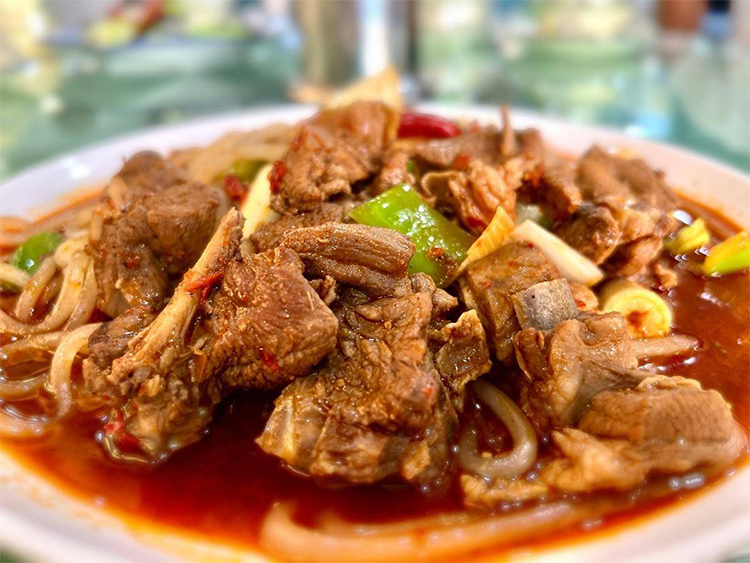Northwest Flavor Soul: Discover the Spicy, Cumin-Scented Stir-Fried Lamb
In the vast landscapes of Northwest China, food and local life are inseparable. Stir-Fried Lamb, a spicy, cumin-forward lamb dish, stands as one of the region’s culinary gems—especially in Ningxia and Gansu. Tender lamb, hot oil, chili, and cumin collide in a sizzling moment that reveals the generous spirit and rich food heritage of the Northwest.
For travelers seeking authentic Ningxia lamb or bold Chinese lamb flavors, this dish is an essential taste adventure.
01 Origin on the Steppe: A Dish Born from Nomadic Traditions
Stir-Fried Lamb originated from the long pastoral traditions of Northwest China. Ningxia and Gansu—crossroads of the Silk Road and home to many Hui Muslim communities—have long been known for sheep herding and open grasslands.
Quick, high-heat stir-frying suited nomadic lifestyles, making efficient use of tender yearling lamb. Local spices like dried chili and cumin enhanced flavor and reduced gaminess. Once a festive treat served to guests in yurts, the dish spread from home kitchens to village markets and modern restaurants, becoming a hallmark of Northwest China cuisine and Ningxia lamb culture.
02 Key Ingredients: Superior Lamb Meets Authentic Spices
The soul of a great stir-fried lamb lies in its ingredients.
- Lamb: Yearling lamb, such as Salt Lake lamb or local high-quality breeds, is prized for tender texture and mild flavor. Thin, even slices ensure quick cooking and melt-in-the-mouth tenderness.
- Spices: Cumin is the star—its warm aroma balances the lamb’s natural richness. Dried chili gives vibrant color and spicy depth, while Sichuan peppercorns add a subtle numbing sensation. Essential seasonings like salt, soy sauce, and cooking wine combine with aromatics such as garlic, ginger, and scallions to complete the flavor profile.
This simple yet bold spice blend perfectly showcases the hearty and unpretentious character of Northwest cooking.

03 Technique and Heat: Where the Flavor Is Made
The essence of stir-frying is speed and high heat. Precision and timing are crucial.
Slice the lamb thinly against the grain for tenderness. Marinate briefly with cooking wine, soy sauce, starch, and a little oil to seal in juices. Heat a heavy iron wok until smoking, add oil, and toss in the marinated lamb—stir just until the color changes, then remove immediately to keep it soft.
Next, fry aromatics like dried chili, peppercorns, garlic, and ginger until fragrant. Return the lamb to the wok, add cumin, chili powder, and a dash of soy sauce or vinegar. A quick toss over high heat coats each slice in spice. The whole process takes just a few minutes—but perfect timing makes all the difference.
04 Flavor and Texture: A Sensory Feast
A plate of Northwest Stir-Fried Lamb delights all the senses:
- Visual: Glossy red-brown lamb with red chili and green scallions.
- Aroma: Roasted cumin and chili mingle with the meat’s natural fragrance.
- Texture: Juicy and tender, with every bite releasing rich, aromatic juices.
- Taste: The warmth of cumin, the kick of chili, and a hint of numbing peppercorn create a balance of savory and spicy that defines Northwest flavor.
It’s bold yet comforting—a dish that captures the rugged charm and hospitality of Ningxia and Gansu.

05 How to Eat Like a Local: Pairings and Customs
Eating stir-fried lamb like a local enhances the experience.
- Best companions: Try it with hand-pulled noodles (latiaozi) or plain steamed rice. Mixing the sauce into rice or noodles is a must. Many locals enjoy eating a raw garlic clove alongside—it intensifies the aroma and balances the spice.
- Dining style: Often served with skewers and cold beer at lively night markets, this dish is meant for sharing—perfect for a festive night with friends under the open sky of the Northwest.
06 Traveler Tips: Where and How to Find the Best
If you’re visiting Ningxia or Gansu, here’s how to enjoy the most authentic stir-fried lamb:
- Local restaurants: Look for popular halal (Qingzhen) eateries or those specializing in beef and lamb—they use fresh, traditional ingredients.
- Night markets: The smoky aroma, sizzling woks, and spicy air make these markets the best spots for an unforgettable serving.
- Rural farmhouses: In places like Zhongwei (Ningxia) or Linxia (Gansu), farmhouse restaurants offer freshly prepared lamb straight from the pasture.
Order tips: Choose tender cuts like tenderloin or hind leg. If you prefer less spice, say “mild” or “no chili.” After exploring landmarks like the Western Xia Tombs, Shapotou Desert, or Jiayuguan Fort, reward yourself with this hearty local favorite.

07 Home-Friendly Recipe: Recreate Northwest Flavor
Want to bring Northwest China flavors to your kitchen? Try this easy version:
Ingredients:
300g thinly sliced lamb, 2 tbsp ground cumin, 1 tbsp chili powder, scallions, ginger, garlic, 5–6 dried chilies, a few peppercorns, soy sauce, cooking wine, starch, salt, and sugar.
Steps:
- Marinate lamb with soy sauce, wine, starch, and oil for 15 minutes.
- Heat wok until very hot, add oil, and stir-fry lamb until color changes; remove.
- Fry peppercorns, dried chili, scallions, ginger, and garlic in oil.
- Return lamb, add cumin, chili powder, salt, and sugar; toss quickly over high heat.
- Finish with fresh scallions and serve immediately.
Tip: Keep the wok very hot and the stir-frying fast—this locks in tenderness and aroma.
08 Conclusion
Stir-Fried Lamb from Northwest China is more than a dish—it’s a story told through flavor, heat, and spice. It reflects nomadic roots, Silk Road exchanges, and the generous warmth of local people.
Each bite carries the essence of Ningxia and Gansu, offering travelers a delicious bridge between tradition and adventure. When you journey through the Northwest, don’t miss this sizzling, cumin-scented specialty—it’s the taste of the steppe on a plate.


